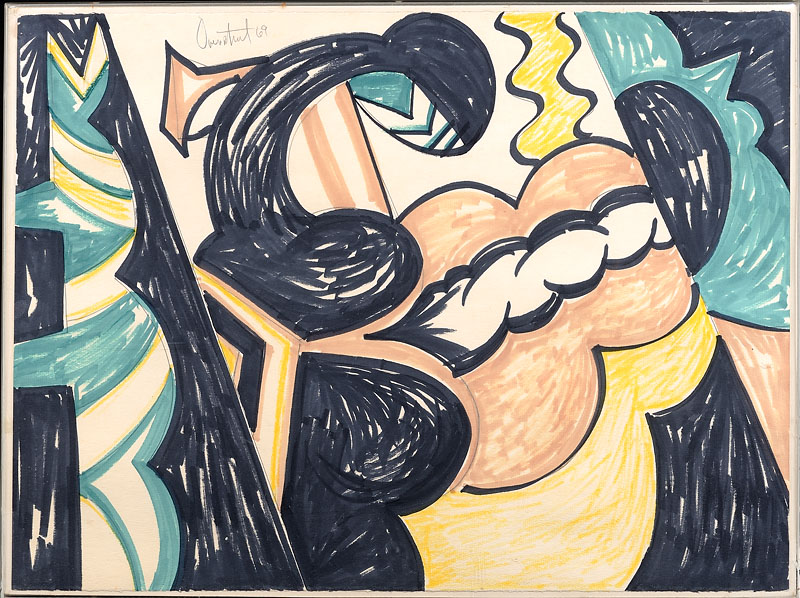Joe Overstreet (b.1 933)
Joe Overstreet was born in Conehatta, Mississippi, in 1933. His family relocated five times before settling in Berkeley, California, in 1946. After graduating from Oakland Technical High School in 1951, he joined the Merchant Marines and traveled the world, off and on, until 1958. He also studied art at Contra Costa College and the California School of Fine Arts in the early 1950s. While living in San Francisco he was mentored by Sargent Johnson, who was a passionate supporter of black artists and a major intellectual influence on Overstreet. He gave his first solo exhibitions in San Francisco, at venues such as the Vesuvio Cafe, and took part in the North Beach area Beat scene.[1]
From 1955 to 1957, he worked as an animator at Walt Disney Studios in Los Angeles. Frustrated by the repetitive nature of the work, and increasingly drawn to New York painting, he moved to New York City with his friend, the poet Bob Kaufman, and worked for a time designing window displays for department stores.[2]
It was in the Cedar Tavern in Greenwich Village, Overstreet recalled later, that he received his "real art education and development". At the time it was a hangout for Abstract Expressionist painters and Beat writers, and Overstreet had many edifying discussions there with artists such as Hale Woodruff, Romare Bearden, and Willem de Kooning. Woodruff encouraged him to incorporate African elements in his work. Overstreet lived for a time in a loft above jazz musician Eric Dolphy, before moving to an artists' community in the Bowery, where he remained for 15 years.[1]
African-American abstract artists have often been overlooked by critics and historians, especially within the Abstract Expressionist movement.[3][4] Perhaps for this reason, Overstreet first gained recognition for his socially-themed works of the 1960s rather than as an abstract expressionist.[5]
In the mid-1960s, Overstreet became active in the Civil Rights Movement and the Black Arts Movement. He organized exhibitions and projects for black artists, and worked with Amiri Baraka as Art Director of the Black Arts Repertory Theatre and School (BARTS) in Harlem. It was during this period that he created one of his best known (and least abstract) paintings: The New Jemima, which subverts the stereotypical black image of Aunt Jemima. Unlike the original character, a domestic servant who exists to please others, Overstreet's Jemima gleefully wields a machine gun. Another social protest piece, Strange Fruit, was inspired by the eponymous anti-lynching song made famous by Billie Holiday. Birmingham Bombing was a response to the 16th Street Baptist Church bombing in which four schoolgirls were killed.[6]
Years later, when asked if he saw any conflict between his belief in the universality of art and his socially-themed paintings of the 1960s, Overstreet responded, "...I think when you look at Catholic Christian art, that's universal, isn't it? When you look at Michelangelo, sixteenth-century art, is that not universal? Isn't that social?...I don't think Aunt Jemima with a machine gun is any less universal than what I'm doing now."[6]
During this period, Overstreet took part in many group and solo exhibitions in New York and California. He began working with shaped canvases, which eventually led to other innovations. In the early 1970s he created a "nomadic art" series using loose canvases suspended in air by ropes and dowels; the effect is reminiscent of the tents and tepees of nomadic people and the sails of slave ships.[7] From 1970 to 1973 he taught studio courses at the University of California at Hayward.[1]
In 1974, with Corinne Jennings and Samuel C. Floyd, Overstreet co-founded Kenkeleba House, an East Village gallery and artist center, to promote minority artists. According to Jennings, black artists were so chronically underrepresented in mainstream galleries at the time that starting a new gallery was preferable to "fighting the Whitney". The neighborhood was then a low-rent area plagued by drug-related crime; in recent years, it has become gentrified. Kenkeleba House is named for a West African plant (Combretum micranthum) prized for its medicinal properties. The gallery displays mostly large works and large group exhibits and includes an outdoor sculpture garden.[8] It also hosts educational programs such as artist lectures and performances. Overstreet still keeps his studio at Kenkeleba House and serves as Artistic Director.[6]
As a young artist in the 1990s, Odili Donald Odita worked at Kenkeleba House, where he was astonished to discover the work of so many older, and relatively unknown, African-American abstract artists. He later said he felt indebted to them for their persistence in the face of an unappreciative art market. Odita began interviewing abstract painters from the 1970s and 80s, such as Howardena Pindell, Alvin D. Loving, Edward Clark, Frank Bowling, and Stanley Whitney, and has since begun lecturing about them at universities.[3]
In the 1980s, Overstreet worked on a commission to produce a series of 75 steel and neon panels for the San Francisco International Airport.[1] He also created his semi-figurative Storyville series, which recalls the New Orleans jazz scene of the early '40s.[6] While exhibiting at the Dakar Biennale in Senegal in 1992, he visited the House of Slaves at Gorée, an experience that led him to produce his Door of No Return series. Over the next two years he explored the possibilities of paint texture in large, stretched canvas paintings that reflect his interest in sacred geometry. In his Silver Screens and Meridian Fields of the early 2000s, his interest in transparency led him to paint on steel wire cloth.[1]
Overstreet's work has been included in solo and group exhibitions at museums and festivals around the world, including the Tate Modern in London, the Dakar Biennalein Senegal, and the Tokushima Modern Art Museum in Japan, and is included in the permanent collections of the Brooklyn Museum, the Everson Museum, the Oakland Museum,[9] the Menil Collection, and many others.[7]
Bio courtesy of www.wikipedia.com. Link to full bio: https://en.wikipedia.org/wiki/Joe_Overstreet

Untitled
Mixed media on paper
25x18 inches
1969
Signed and dated
Photo credit: John Wilson White Studio